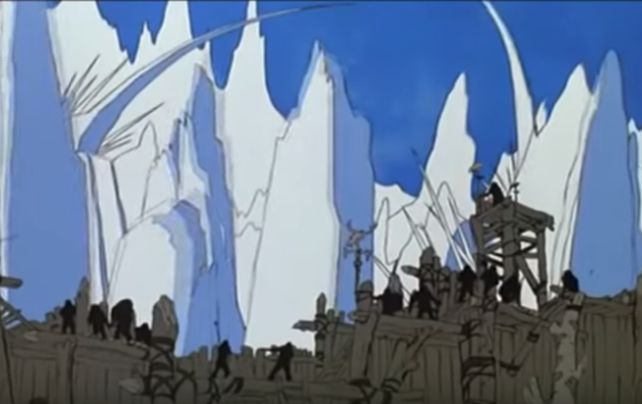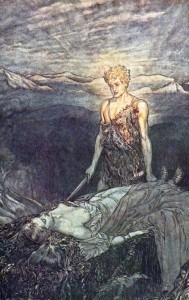Personal Pocket Dimension

bard & wizard spell
1st level
conjuration
verbal, somatic, material
duration 1 hour
This spell creates a small extraplanar space that the caster can put an object into.
The caster can then later retrieve the object as per the action for drawing a weapon.
The object can not be larger than a tiny creature or a staff at 1st level. At higher levels objects can be one size category larger per higher level spell slot. Also, the spell can last longer, increasing to a day, week, month, and year with higher spell slots. Both size and duration can be altered in the same casting of the spell. For example, using a 9th level spell slot would allow the caster to secret away a gargantuan object for a year.
Material Component: a cloth or garment such as a sleeve or veil, behind which the caster appears to hide the object and from which the caster appears to withdraw the object.
Posted in 1st edition D&D, 3rd edition Dungeons & Dragons / d20 fantasy / Pathfinder, 5th edition Dungeons & Dragons, Fantasy, Spell and tagged magic spell by Adam A. Thompson with no comments yet.
The Eight Sacred Armors
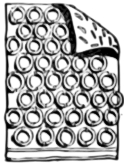
Many scholars who study dusty ancient tomes have read of the Sacred Armors of, for example, Heaven, which lends glowing wings of flight to the wearer, or the unfortunately common Demon Armor, a loathsome clawed abyssal creature that one can wear as protection. And the similarly tragic Berserker armor of Limbo. Only those with true Guts can survive that mythic armor for long, as the wearer can not feel any pain while wearing it. But quasi-astral pshyoastronologimists that I have visited with postulate that each phase of octoethossection will tend to evoke an iconic armor into demihumanoidimaginationmanefestation vortices.
Hence, as observed during long multicosmic explorations, with protective bonuses measured in the +1 to +4 range:
- “Heaven”, the Angelic Breastplate grants the wearer flight speed 60 feet per round and use of the light spell at will.
- “Mercy” suit of golden chain mail that grants the wearer a bonus of 1d12 HP to any healing spell or effect and is considered light armor.
- Berserker Armor which grants a the wearer advantage on Strength checks and on Saving Throws against effects that impose a condition on the wearer, such as webs that restrain or spells that charm. Additionally, the DM secretly keeps track of HP for the Player’s Character.
- The Helm of Truth grants use of the spell Detect Thoughts to wearer at will, but is unable to lie unless they succeed on a saving throw.
- The Shining Crown – most scholars agree that this headpiece does not exist, but there are some who believe it is possessed by the Lady of Pain.
- The Skull Knight’s Helm – wearer can see invisible and ethereal creatures and objects, has advantage on Perception checks to see hidden foes, can detect magic at will.
- Chaos’s Shield allows the bearer to resist a chosen damage type for one hour, once per day, as a reaction.
- Inferno Armor grants fire immunity and deals 1d4 fire damage to natural or unarmed attackers.
- Shadow Armor gives the wearer advantage on Stealth and cold resistance.
- Demon Armor (per DMG).
It has been observed that these powers grow in proportion to the scale of heroic action achieved by their holders, which enforces the theory that these armors are spirits from the outer realms who have taken on a form that interacts with the wyrd skein of fate and elevate the glory of those who bear them. I postulate that these spirits in material form are somehow also fueled or enhanced by the resultant psychic-spiritual energy of their bearers.
-Alidol, High Mage of Soguer
Posted in 1st edition D&D, 3rd edition Dungeons & Dragons / d20 fantasy / Pathfinder, 5th edition Dungeons & Dragons, Magic Item and tagged alidol's writings, magic armor by Adam A. Thompson with no comments yet.
The Lair of the Wyrm
This fantasy role-playing game scenario is the lair of the Wyrm of Etiniga, the draconic creature from the adventure: The Suitor’s Challenge. I also used a shorter, modified version of this dungeon for the medieval age dungeon in season 2 of Class of 198x. This map could also serve as basically any dragonlike creature’s lair in your home game.
Creatures
As the person running the game, select a number and type of creatures for the below encounters according to what seems appropriate to the characters attempting to delve the dungeon. The scenario probably entails navigating three to five encounters, so a gamut of medium and hard encounters is probably appropriate, based on Player Character number and level (consult your Monster Manual and Dungeon Master’s Guide or equivalent books for more guidelines on this topic). My advice: make it hard, but not impossible. Don’t be afraid to throw in a couple of reinforcements (on either side) when appropriate, but overall try to present a difficult but achievable scenario.
Entrance
Situated in a large natural cavern hidden in the ravine past the hills north of Vistola, the lair of the cursed Wyrm of Etiniga’s maw stands open. A cavern in the side of a ravine, twenty feet wide and receding into the yawning darkness of a larger chamber ahead. Close examination of the gravely ground reveals clawed footprints of a variety of sizes, among dry old bloodstains.
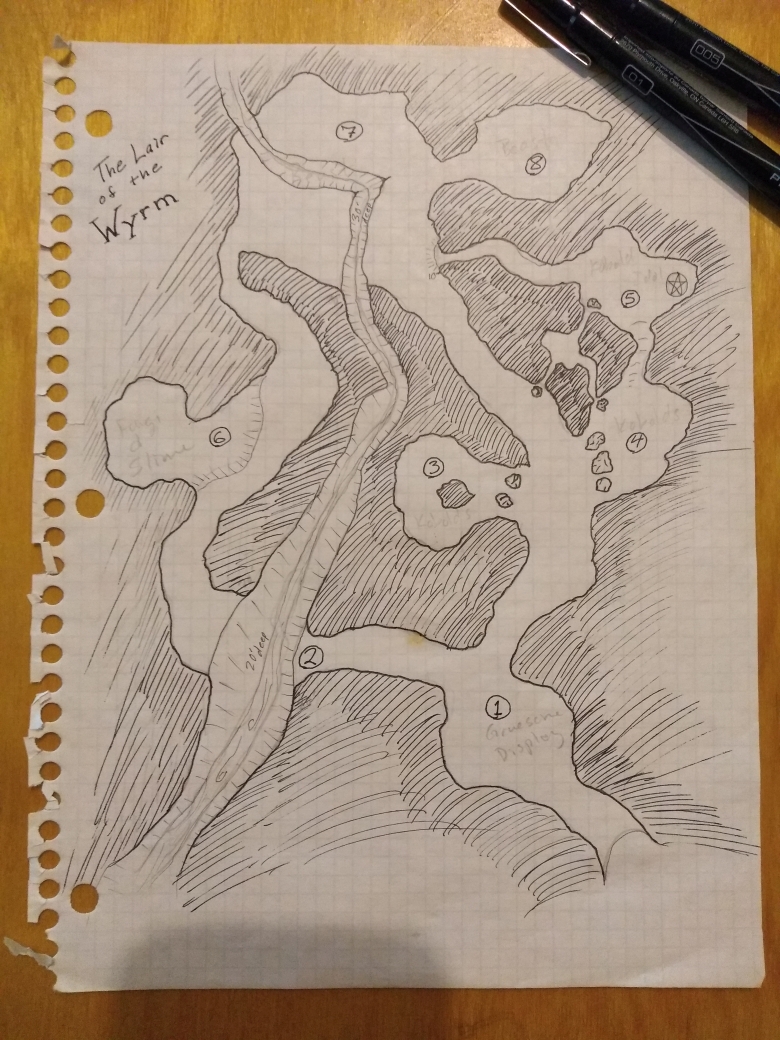
The Lair of the Wyrm (5 foot squares)
Areas
1) Gruesome Display
A pile of broken animals, people, and weapons have been arranged into a sort of horrid meat-drying scaffolding in this chamber. The corpses are in varying stages of decay and bear jagged bite marks on whatever is left of them. Broad natural stone passages lead to the left and to the right.
Loud noises in this chamber will alert the kobolds and lizardfolk to the right in areas 3 and 4.
2) Chasm
This passage is bisected by a twenty foot deep crack in the stone, at the base of which a shallow underground stream flows. The walls bear black moss and faintly glowing white lichen.
Climbing up or down is a difficult task (DC 20) due to the moisture and the slick growths on the walls.
3) Lizardfolk
The warband of lizardfolk who have come to the caves to worship the Wyrm and raid the countryside live in this cavern, eating from the corpses in area 1 and otherwise being served by the kobolds. Among them is a war shaman who will aid them with magic against intruders. The lizardfolk warband spends its time eating, resting, and raiding the surrounding countryside, dragging back both shepard and sheep upon which to feast.
They will lead the attack against intruders, backed up by the kobolds and the shaman as their leader.
4) Kobolds
Numerous kobolds already lived in nearby caves when the Wyrm arrived, and have come here to join in the worship and feasting. They mainly live in this cavern, and perform most of their domestic tasks here from cooking over small firepits to coppersmithing spear heads and knives.
They will join the lizardfolk in defense of the caverns, taking advantage of the narrow passages that connect areas 4, 5 and 7 to flank and sneak up on intruders. Medium sized creatures must squeeze through the narrow passages at half speed, and are at disadvantage to attacking foes and defending themselves.
5) Idol
The kobolds and lizardfolk have built a shrine here to the Wyrm: a stone block with a silver-and-gold gilded idol of the serpentine Wyrm with eyes of garnet. Piled up at the base of the altar is the wealth of the tribe, including several boxes of sandalwood incense, one hundred gold coins, twice as many pieces of silver coin, and a pot of healing balm which will heal 2d4+3 hit points when applied to wounds.
The shaman will make their last stand here against intruders and will fight to the death to protect the shrine.
The idol itself is is worth 200 gold, but it is also warded with a curse, and the first non-lizardfolk to touch it will take 3d8 points of acid damage, unless they make a Constitution save for half damage.
6) Fungi and Slime
Putrid-smelling green slime drips from the ceiling of this shallow bowl of a cavern. Below, grayish gunk stirs slightly among shards of bone and dark smelly spoor.
Creatures entering the cavern will be dripped upon by the green slime on the ceiling, and attacked by the gray ooze on the ground. Unless they succeed on stealth checks, those who pass by this cavern are likely to be pursued by at least one gray ooze.
For lower level parties, consider using Blue Oozes instead of gray oozes.
7) Chasm
This large cavern is split by a 30 foot deep crack in the stone ground.
The chasm is difficult to climb up and down, but the Wyrm can arch across it without difficulty.
Loud noises in this cavern will attract the ire of the Wyrm.
8) Wyrm
The Wyrm of Etrigia lies here, a gleaming shiny black mass of coils and claws, making gruesome noises.
If using the True Love plot twist version of this adventure, medium difficulty (DC 15) Sense Motive skill checks will reveal the beast appears to be in pain, and is writhing and scratching at itself, biting its tail, all without piercing its scaly hide. With successful Perception checks, of if the princess has accompanied the party she will recognize the silver necklace around the serpentine creature’s neck as the one she gave to her true love. If she can kiss the willing beast, the curse will be broken and the Wyrm will revert to their former self.
Otherwise the Wyrm will attack, kill, and then eat any who intrude, or those making loud noises in the adjacent cavern (area 7, above).
The Wyrm‘s hide is invulnerable to non-magical slashing and piercing damage, and will make a grand prize for any who can collect it. If the Wyrm is slain its scales can be made into hide armor that grants the wearer resistance to slashing and piercing damage. This legendary magic item requires attunement.
Posted in 1st edition D&D, 3rd edition Dungeons & Dragons / d20 fantasy / Pathfinder, 5th edition Dungeons & Dragons, Adventure, Fantasy, rules agnostic by Adam A. Thompson with no comments yet.
Mind Flayer Lair
I came up with this dungeon when my players wandered into hex C2-20 in the classic Dungeons & Dragons adventure Descent Into the Depths of the Earth, a great old adventure which encourages DMs to fill inthe blank encounter areas with dungeons of one’s own design.
One of the players was playing a Warlock with the Far Ones pact, and I wanted to introduce a re-occurring Mind Flayer antagonist who would be a contact for the Warlock for their pact. The result was a nasty little dungeon filled with traps and horrors. When the Mind Flayer within contacted the warlock telepathically to offer magical secrets the Player Characters followed them right in.
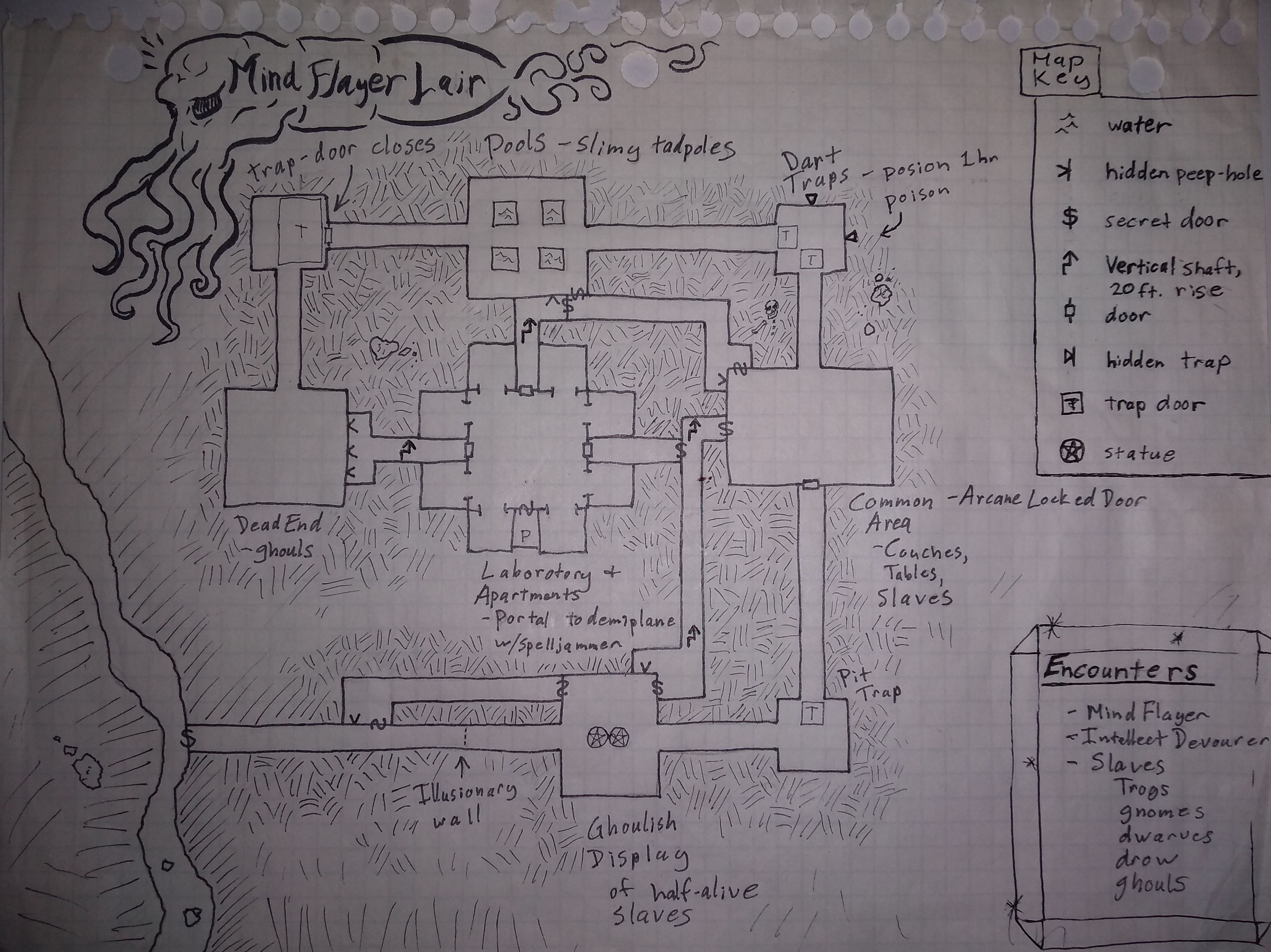
The evil architects of this stronghold forced their slaves to build it as a spiraling trap, with a raised, hidden central area from which they could use their psychic powers on hapless intruders. As their prey make their way through the outer areas, encountering the mind-controlled slaves who dwell there, the Mind Flayers will lurk, peering through hidden peep-holes to use mind blasts and charm powers on their victims. If discovered, the Mind Flayers will retreat up 20 foot vertical shafts to the central passages and behind further secret doors.
Posted in 1st edition D&D, 5th edition Dungeons & Dragons, Adventure, Fantasy, Location, Lore / Worldbuilding, rules agnostic, Trap and tagged Descent into the Depths of the Earth by Adam A. Thompson with no comments yet.
The Vampires of Grimsport
800th POST!
After 12 years and 799 articles detailing new magic items, monsters, spells, characters, encounters, locations, and adventures, Unicorn Rampant Publishing and Claw Claw Bite Magazine are thrilled to present you with this free adventure for Dungeons & Dragons or other fantasy role-playing games.
Thanks for coming with us on this amazing journey of the imagination, and look for this and so much more in the next issue of Claw Claw Bite!
Grimsport
In the land of Findor, where the Hadevar River meets the Soral Sea, the gray city of Grimsport broods. Dark stone buildings with slate roofs cluster around the main square, a short walk up the cobblestone road from the docks. There are found the homes of the ruling Captains’ families. Stone walls separate the inner city from the wooden homes of the tradespeople and serfs. Farms dot the banks of the river further inland.
It is from this city that the region gets it’s moniker “The Pirate Kingdoms.” Grimsport is the largest city in the region and the closest thing to a capital, and the primary source of the raiders that plague the Soral Sea. But in Findor no one rules an area larger than a stronghold or city, save the goblins of the northern wastes.
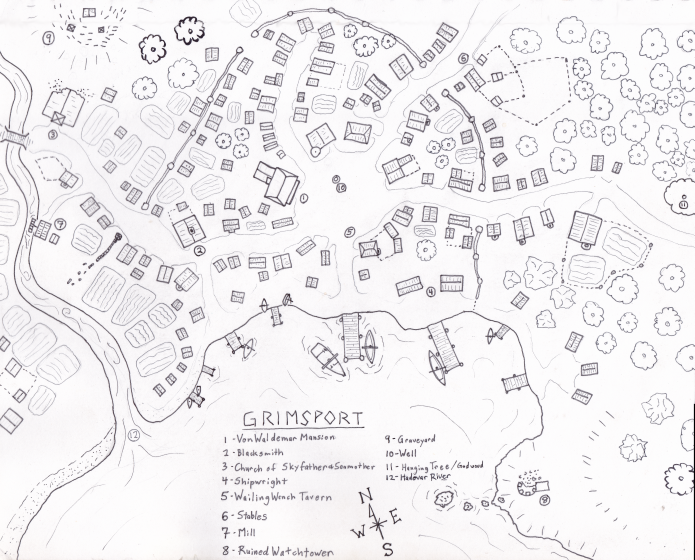
The Town of Grimsport
The boat-owning worthies who make their homes in the city center form the Captains’ Council, the closest thing to a government in this violent port town. They own most of the farmland and assign it to serfs. They serve as the bankers and trade in many goods. Some families have small fleets. Others have but one ship to their names.
The most important Capitans’ families are as follows:
- VonWaldemar – The wealthiest and oldest of the families, with the largest home on the central square. Said to be the descendants of some of the first humans to come to this wild, cold land many generations ago. Old man VonWlademar hasn’t been seen in public in years, and people sometimes whisper about pale, ghostly figures peering out of the heavily curtained mansion windows at night.
- Thyra Askrdottir – Daughter of Askr Vulfethson, Thyra’s exploits as captain of her father’s ship have earned her a reputation as a skilled and ruthless pirate.
- Addis Rígson – Addis owns two ships, which are captained by his two eldest sons Victor and Ricus. His youngest son Sigurd wanders the land seeking his fortune and could be a NPC or hierling met here or elsewhere.
- Soljev – Captain Soljev sails the Drunken Siren.
- Ragnhild – Captain of the Kraken’s Maw and the Burning Spear.
- Kromulf – The new captain of the Black Hydra, an infamous pirate ship that Kromulf wrested from its previous captain.
- Gunnar Smithson – Owns a small fleet of fishing vessels, sailed by his extended family, and the ship Silver Wave.
- Malte One-Hand – An old captain, now mostly retired due to his ship being in poor repair.
- Gull Erland – His ship is in drydock for repairs which he cannot afford.
- Eberhard the Bloody – Has one small ship and a reputation as a unpredictable and violent man.
- Bjarke Littlebear – Sails a large fishing boat with his five sons.
Locations
- The Wailing Wench – This rowdy tavern sits on the road between the main square and the docks, and is always full of sailors. Thieving, fighting, kidnapping and every other type of crime are regular occurrences here. A fenced pen and stables are attached to the back for travelers animals.
- Church of the Sky Father and Sea Mother – attended by a priest and priestess, with smaller shrines to other local dieties such as Krom, etc.
- Smithy – Worked by a smith and a team of apprentices and journeymen, with a good assortment of tools, weapons, and armor, used or ready-made.
- Shipwright – Currently building a 20 foot wooden currach.
- Tradespeople
- Farms
- Hanging Tree & Godswood
- Ruined Watchtower – built long ago by the Captain’s council, no repairs have ever been made to the watchtower. Over the decades it has fallen into ruin, and the whole north wall of the two-story tower has collapsed. None know about the small cache of treasure buried there.
Adventures and Encounters in Grimsport
- Thieves in the Swamps – A band of thieves operates out of the swamps to the west. They secretly use Malte One-Hand’s ship as storage for their stolen goods.
- Pressed into Service – Press gangs round up drunks and force them to crew the captains’ ships. While the Player Characters are crewing the ship any sort of mishap or adventure could befall them. The ship could sink in bad weather, throwing the heroes upon some unknown shore. Perhaps they are forced to scout a fortress the Captain wishes to raid, or perhaps the PCs are forced to be the first wave of the attack. The Lilend at the Stormking Rocks might lure them to her isle and send them after the Rune of Life in the shadowlands at the edge of the Land of the Dead.
- Pickpockets and Muggers – The rough rogues of Grimsport will take any opportunity to enrich themselves if they see people not paying attention to their purses, or who they think are weak enough to rob (preferably one character who they follow until they outnumber their victim).
- Dueling in the Streets – Disputes in Grimsport are often settled personally, and duels are a common form of conflict resolution, weather to first blood or to the death. In such a place the Player Characters could easily become embroiled in a dangerous situation. Mistaken identity, false accusations, or just disrespecting someone or being in the wrong place at the wrong time could result in a duel.
- Escaped Slaves – Some slaves captured in a raid have escaped and a reward is offered for their return.
- Beggars – Old crippled fisherman and seamen beg for alms in the square and by the docks.
- Grave Robbers – Graves dug on the hill behind the church are always found empty a week or so after burying. No one in town really seems to care, as this has been going on for as long as anyone can remember. Under cover of night, the ghouls who crew the VonWaldemar’s ships and attend them in their mansion are digging up the graves to feast upon the rotten bodies. Investigation after the next burial (a common occurrence) will lead the Player Characters to the basement door of the VonWaldemar mansion.
- Land Dispute – One of the Captains wants some land currently owned by another Captain and the Player Characters are asked to undertake some skulduggery. Burn the crops, poison the well, kill the farmers, or whatever is needed to get the current tenants off and new tenants on.
- Missing Servant Girls – Player characters who spend much time in town will hear that servant girls sometimes go missing. Investigation leads to the ghouls in the basement of the Von Waldemar mansion (see map).
VonWaldemar Mansion Areas
- The stone exterior, high windows, and peaked slate roofs of this mansion site like a dark and gothic castle on the town square. A fence surrounds the front and sides of the windowless bottom floor, and a stair in the back leads down to the basement entrance. The front door will not be answered unless it is being battered down, and then by ghoul butlers and Matrok, an armored wight who will demand to know what business interrupts the VonWaldemar’s rest.
- The ground floor has several mostly-empty halls, a decorative armory, and a small library of dusty common books. An undead shadow, the restless spirit of one of the long-dead Von Waldemars, haunts these halls and will warn Gunnar of any intruders.
- The basements are overseen by a ghoul named Harod and a flesh golem doorman named Pip. Peasant servants prepare food while ghoul footmen serve the vampires upstairs. The locked vault contains a large amount of plateware, iron ingots, and other loot pillaged from around the Soral Sea, along with several chests of gold, silver and copper coins, and two empty caskets where the vampires will flee if defeated.
- The sub-basement holds cells, a half-flooded chamber where corpses float in briny water, and their horrible feeding area. VonWaldemar, the vampire master of the house, is sometimes found here feeding with the ghouls among the cracked bones of countless people. A secret passage leads to a small, rough-hewn passage which leads to the town well, and is guarded by a gargoyle.
- The VonWaldemar family quarters are upstairs, as are the quarters of their wight guards and ghoul servants. Gunnar VonWaldemar and his daughter Helde are centuries-old vampires, and the only remaining members of the family. They are attended by several ghoul servants. Their quarters contain much finery, and any victims that they are feeding from. The windows in the vampires’ quarters have the shutters nailed closed and reinforced so that no sunlight can enter. Gunnar is a 7th level wizard, and his chambers contain his spellbook, many magic scrolls, and correspondence with someone who signs with a unique snowflake-like rune (the evil lich White Eye), and who has asked Gunnar to use an enclosed scroll of glacial onslaught to draw the oncoming unnatural summer ice south, down the river. If necessary, the VonWaldemar vampires will become bats or rats and use the ratholes, which crisscross the entire mansion with a network of rat-tunnels, to escape.
VonWaldemar Mansion
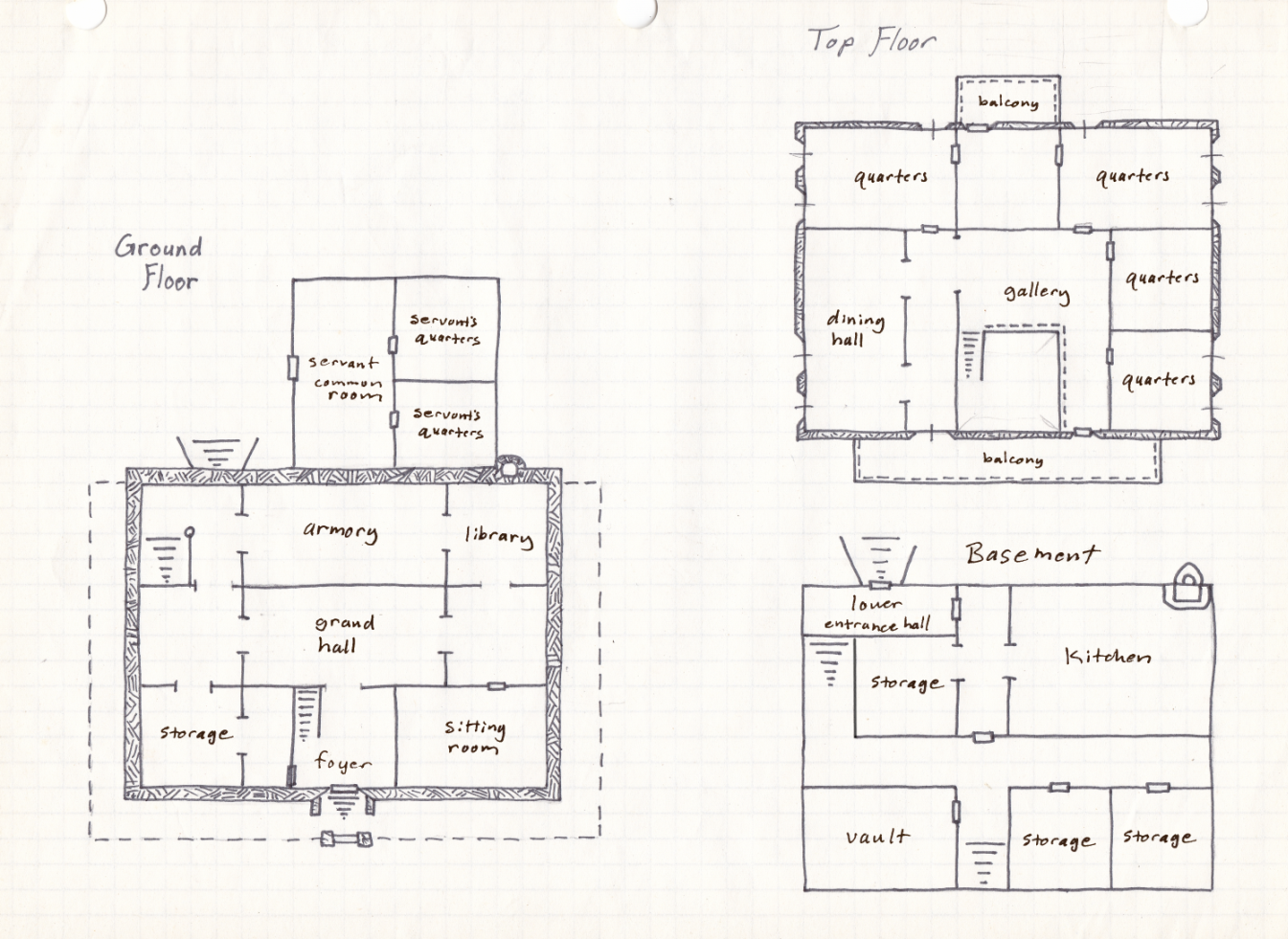
VonWaldemar Mansion Sub-Basement
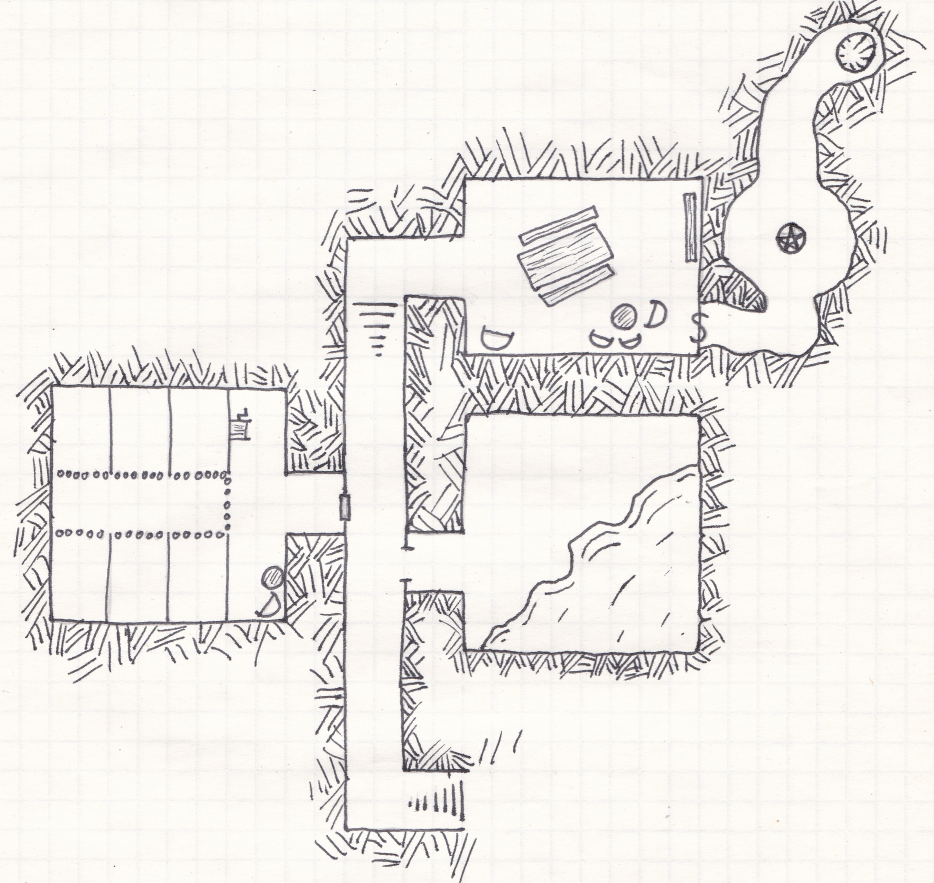
Background image by Nikolai Rerikh, Guests from Overseas, 1901, Tretyakov Gallery, Moscow (public domain)
Posted in 1st edition D&D, 3rd edition Dungeons & Dragons / d20 fantasy / Pathfinder, 4th edition Dungeons & Dragons, 5th edition Dungeons & Dragons, Adventure, Fantasy, Location, rules agnostic and tagged Soralia by Adam A. Thompson with no comments yet.
Glacial Onslaught
Posted in 1st edition D&D, 3rd edition Dungeons & Dragons / d20 fantasy / Pathfinder, 5th edition Dungeons & Dragons, Spell by Adam A. Thompson with no comments yet.
The Suitors’ Challenge
an adventure seed for fantasy role-playing games
A common theme in ancient tales involve romance preceded by obstacles. Brunhilde, Atlanta, and Penelope all provide examples of these types of stories. This scenario presents an rich adventure idea that can incorporate heroic deeds, intrigue, and plenty of opportunities for role playing.
In these tales the young prince or princess is of age to marry. However, for whatever reason, someone does not want the marriage to take place. Perhaps the young princess wishes to spend her days hunting and running in the woods. Or the prince’s mother is jealous of her son’s affections and does not wish to have a rival. Maybe the princess’s kindly father simply cannot stand the thought of an unworthy person marrying his beloved daughter. It could be that an oracle has spoken a prophecy that unless a monstrous serpent is slain the princess will die of its poison. Or the princess is next in line of the royal succession and does not want a foreign husband ruling in her stead.
For whatever reason they have set conditions upon those seeking the hand of the young bride or groom. Perhaps the suitor must defeat a nearby monster, or beat the princess herself in a foot race or a contest of feats of arms. They could be sent to a distant land to retrieve some talisman or artifact to prove their worth. There may be additional penalties imposed for those who fail – perhaps they are stripped of land and title or exiled. Some may decree that those who fail the trial be put to death, in order to further dissuade any potential suitors.
The adventures may have been enlisted by another kingdoms’ young prince or princess to aid them in gaining the hand of the potential spouse. Or perhaps one of the adventures themselves is enamored of this young person. Or a combination of the two: perhaps the adventures are enlisted to aid someone and then find that one of their number is smitten by the young prince or princess.
The challenges themselves should be arduous. A chariot race can be extremely dangerous. A contest of archery might involve treachery with poison-coated arrows. Perhaps the nearby monster has a scaly hide which cannot be cut by mortal blades. Maybe the young princess has magical aid such as a belt of giant strength or help from the gods. The bride’s unwilling parents may interfere with the adventures. Conversely if they wish the marriage to take place they may help a chosen suitor. Rival suitors may well try to trip up or even kill their opponents.
Presented below is a short adventure built on this theme. (more…)
Posted in 1st edition D&D, 3rd edition Dungeons & Dragons / d20 fantasy / Pathfinder, 5th edition Dungeons & Dragons, Adventure, Fantasy and tagged Findor by Adam A. Thompson with no comments yet.
The Sword of Storms
This gleaming blue-steel blade is tied to the power of the storms, and in addition to it’s +2 enhancement bonus, deals an extra 1d6 points of lightning damage on a hit. Those who wield it resist 5 points of lightning damage from any source. Additionally, the weapon can strike with the power of a thunderclap – once per day, upon a successful blow, the wielder can force an opponent to succeed on a DC 15 Constitution, Fortitude, or Petrify/Polymorph saving throw, or be pushed back 10 feet and stunned for one round.
Posted in 1st edition D&D, 3rd edition Dungeons & Dragons / d20 fantasy / Pathfinder, 5th edition Dungeons & Dragons, Equipment, Magic Item and tagged sword by Adam A. Thompson with no comments yet.
Serious Injuries, Scars and Maimings
Axes grind and maces clash as wounded fighters fall to the ground
Severd limbs and fatal woundings, bloody corpses lay all around
Iron Maiden
“Invaders”
Want to up the ante in your game? Characters get knocked down just to get back up again? Try these optional rules for character scars and maimings.
Whether blasted in the heart with a ray of white-hot flame, shot in the liver with an arrow, or stabbed in the neck by a raving marauder, some wounds are going to leave a mark, if not result in serious and permanent disability, assuming that the victim survives at all. The maimed, the amputees, the crippled begging outside the temple of Heironious, Aries, or Hextor. All are the evidence of the price of the battlefield. Accordingly, these rules are intended to bring more life to the threats which wound the crusaders.
Optional Rule: Serious Injuries, Scars and Maimings
When a hero or important NPC takes enough damage to be reduced to negative hit points, check on the Serious Injury, Scars and Maimings chart to determine where the blow that laid the character low fell.
With the exception of destroyed organs and severed limbs, which require regeneration to regain, these effects should be reversible through the use of magic such as Restoration, Heal, or other magic or effects that heal permanent ability damage. There are also rumors of magicians and priests who have crafted magical arms and legs for those so hurt, as well.
Serious Injuries, Scars and Maimings (roll 1d20)
| Roll | Effect location | Full description of effects |
| 1-4 | Leg | -2 strength, -2 dexterity, and lose use of wounded limb: roll 1d20, on 1-11 limb is crippled and character moves at half speed, 12-20 limb is severed and character moves at 1/2 speed with a crutch but otherwise must crawl at 1/4 speed. |
| 5-6 | Guts | -4 constitution, sensitive stomach: must eat special diet or additional -1 constitution per day. |
| 5-6 | Groin | -2 strength, -2 constitution, cannot reproduce. |
| 9-12 | Chest | -2 constitution, -2 strength, after jogging or running, make a DC 10 saving throw or be dazed for 1 round. |
| 13-16 | Arm | -2 strength, -2 dexterity, and lose use of wounded limb: roll 1d20, on 1-11 limb is crippled, 12-20 severed. |
| 17-20 | Head | Roll once on Head Chart, below. |
Head Chart (roll 1d20)
| Roll | Effect location | Full description of effects |
| 1-4 | Eye | -2 on perception or spot checks, -2 on all ranged attacks. Second lost eye blinds character. |
| 5-8 | Ear | -2 on perception or listen checks. Second lost ear deafens character. |
| 9-12 | Face | -2 charisma due to serious scarring or deformation of face. |
| 13-16 | Mouth | -2 on all charisma based skills, due to difficulty understanding speech from character. |
| 17-20 | Throat | The character is unable to speak. |
As always, when introducing optional rules like this, especially rules that increase the danger for the player characters, talk it over with the group you’re playing with. Unless everyone consents to having more fun by making the game more dangerous, don’t use them. Nothing makes some players hate playing more than DMs springing new rules on them out of the blue.
These optional rules are compatible with 3.5 D&D, 4e D&D, d20 modern, and Pathfinder RPG systems.
Posted in 1st edition D&D, 3rd edition Dungeons & Dragons / d20 fantasy / Pathfinder, 4th edition Dungeons & Dragons, 5th edition Dungeons & Dragons, Variant Rules by Adam A. Thompson with no comments yet.
A Fast and Simple Critical Fumble Option
I like critical fumbles in my games for a number of reasons. First of all, as a storyteller I like it when disaster strikes. When I’m visualizing and describing a pitched battle I relish the possibility that one of the combatants might slip in the growing pool of blood on the flagstones or over-swing their battle-axe and accidentally strike one of their comrades. It makes the battles feel more real to me, and it also makes combat feel more dangerous.
In practical terms, it does make combat more dangerous for everyone involved. If big monsters might accidentally kill their minions when they’re trying to smash that knight, or if the players might lose their footing and fall prone, then there’s more damage being handed out every round. It makes the monsters go down a little more quickly, but it also exposes the players to more danger. As DM I consider this a win-win because I like my games to feel as dangerous as possible, and I like combat to go quickly.
But I don’t like to slow my games down with looking anything up. I’ve been playing and running games long enough that I know pretty much all the rules by heart, and for my fumble rules I wanted to come up with something that could easily be memorized and that wouldn’t slow down combat with referencing a table. Therefore, I came up with the following optional rule.
Critical Fumbles
Any time an attacker rolls a 1 on their attack roll die, they fumble. Roll another d20 to determine the severity of the fumble.
Die Roll Fumble Result
16-20 Character is off-balance and grants combat advantage until the end of the current character’s next turn.
11-15 Attacker looses their footing and falls prone.
6-10 Attacker drops their weapon or loses their next attack if weaponless.
1-5 Attacker targets an ally or themselves with the fumbled attack. Re-roll the attack to see if it hits the new target.
I like it because it’s nice and simple – there are four results with increasingly dire consequences, so it’s easy for me to remember “off balance, fall prone, drop weapon, or attack self or ally”.
Let us know what you think in the comments below, or on our Facebook page.
Posted in 1st edition D&D, 3rd edition Dungeons & Dragons / d20 fantasy / Pathfinder, 4th edition Dungeons & Dragons, 5th edition Dungeons & Dragons, Variant Rules and tagged critical fumble by Adam A. Thompson with no comments yet.
